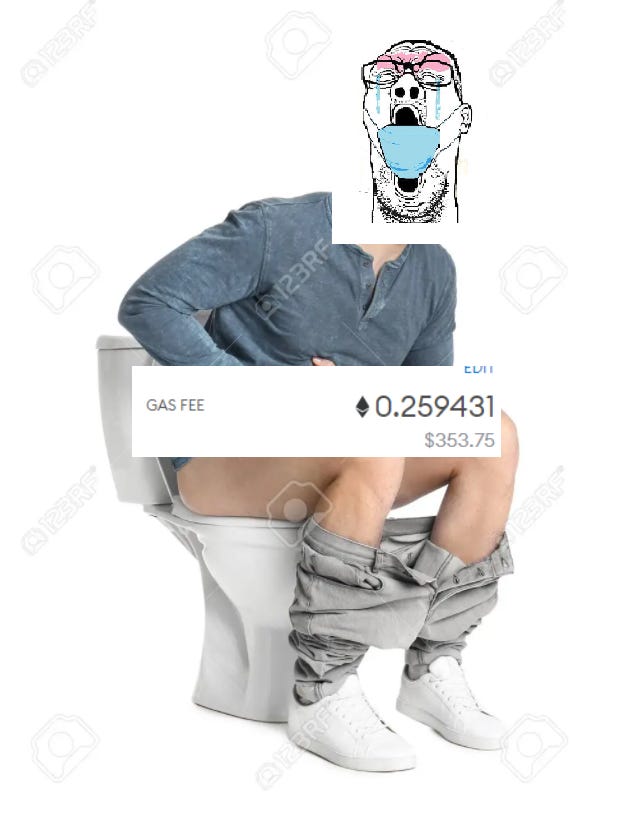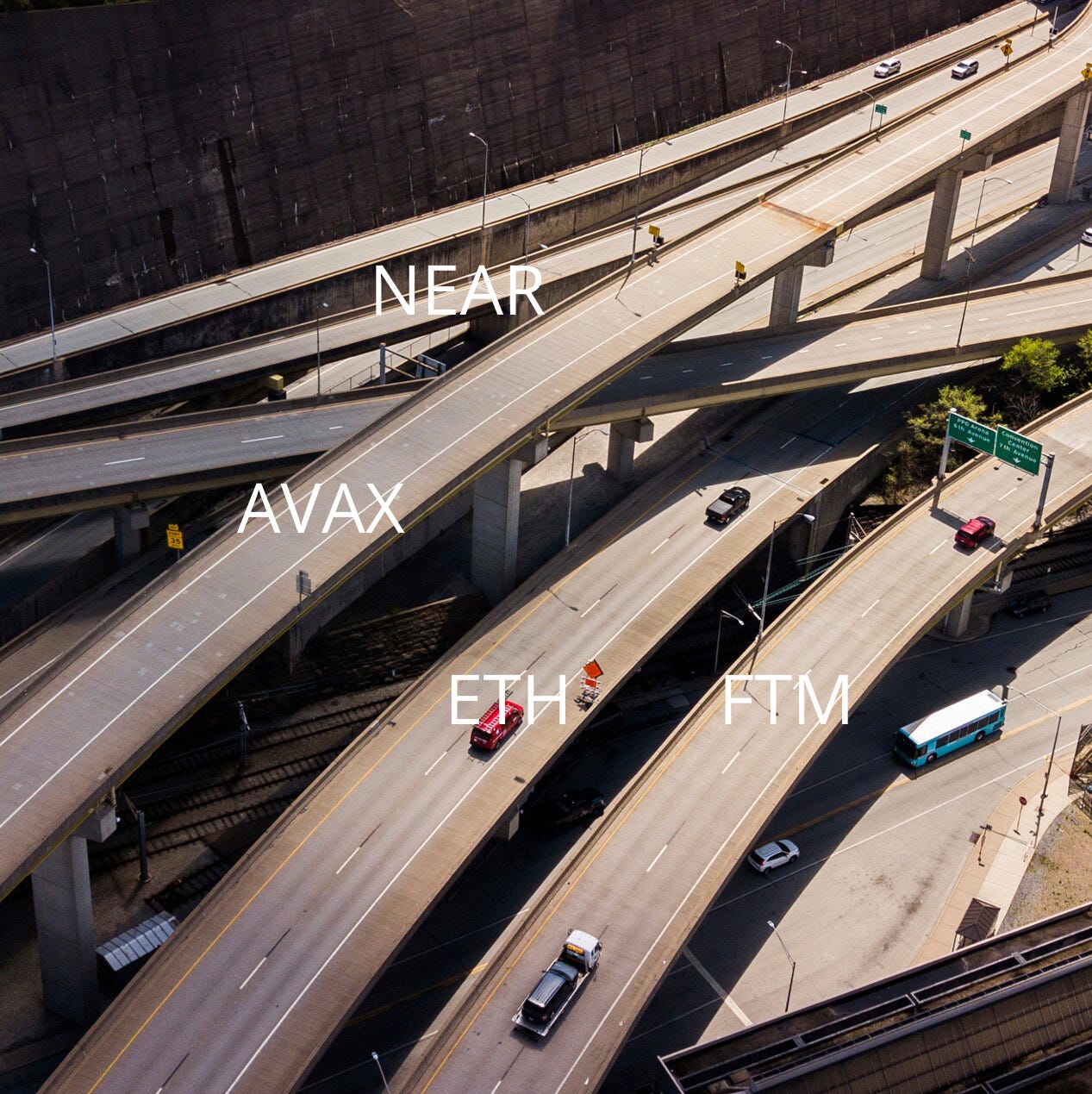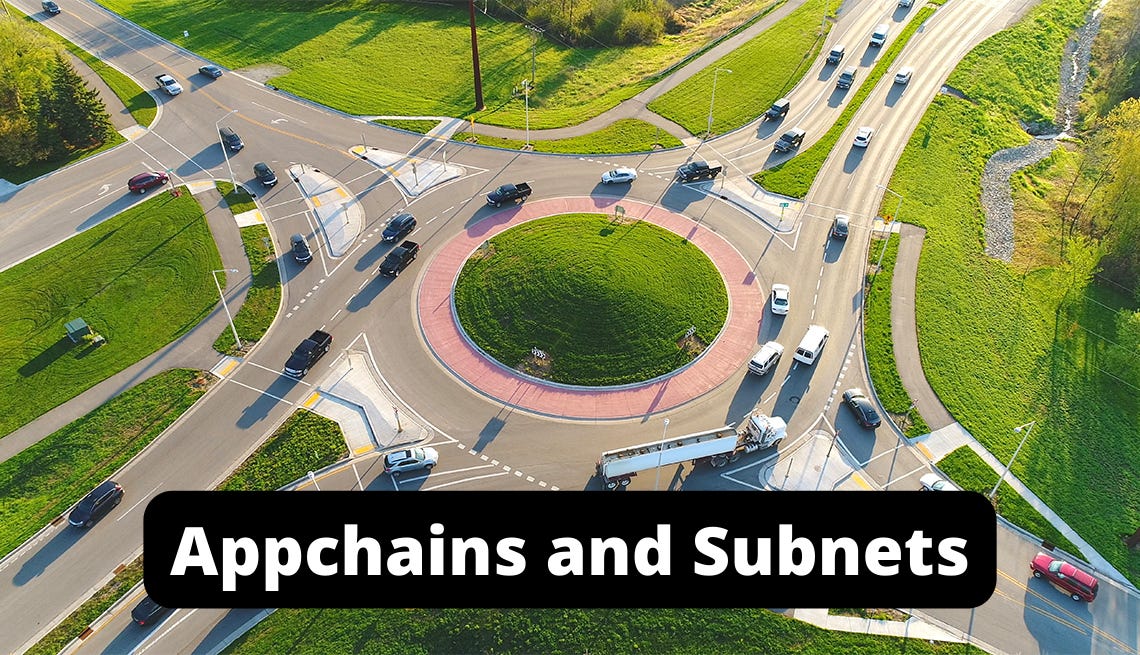Table of Contents:
Introduction: Crypto’s Narrative Evolution Web3 vs Web2
Crypto networks, AppChains, and Subnets — Oh My!
The Bull Case for Appchains
Sources
Introduction: Crypto’s Narrative Evolution, Web2 vs Web3
It was the bullish of times, it was the bearish of times. While some things come and go, such as the many bitcoin and OHM copycats, certain narratives stay, Defi summer, NFTs, and ENS domains, so it goes. Another thing that’s here to stay is Ethereum’s congestion.
There are hundreds of thousands of projects launching on Ethereum, NFTs, Defi Farms, DAOs, and never-ending forks. Everyone’s heard it, it’s a horse beaten to a pulp, but ETH has absurd gas fees. This can be attributed to the amount of activity Ethereum receives. This will only worsen as the number of Ethereum’s users grows. So what if we had application-specific chains for specific purposes? A chain for NFT marketplaces and development, another for the METAVERSE, and another for Defi protocols. This forms the basic thesis behind emerging appchains, but more on that later. Ethereum’s problem is best understood with a traffic analogy. Ethereum is similar to a congested highway, where the users on the blockchain are the cause of congestion. Layer2 solutions, such as Arbitrum, Optimism, or ZKsync on Ethereum provide the much-needed efficiency demanded. This is analogous to cutting down on the number of cars on the road and using public transportation. Other solutions essentially build an entirely new road. This year alone there has been an explosion of activity from L1 chains. AVAX, FTM, and SOL have made a killing in user base growth and that trend will likely continue. However, there’s a third option that is an amalgamation of the two that is only in the beginning stages of its emergence. Appchains and Subnets.
Crypto networks, AppChains, and Subnets — Oh My!
Now, dear user, you’re probably thinking: Ohh my, what are these appchains and subnets, and more importantly, can I make money off of em? I’m glad you asked. According to the Octopus Network, they are an up-and-coming paradigm in the crypto space, and we’ll get to the latter half of that question later. Appchains and subnets can be thought of as application-specific blockchains for certain types of protocols, a chain specifically for NFTs or Defi protocols if you will. How does that work? Well… that’s complicated, but sticking to the early traffic analogy may help. Application-specific chains may function as the main road with many intersections connecting to other more specific chains. There are multiple application-specific chains with their way of accomplishing their purpose. There’s Polkadot, AVAX subnets (coming soon), the Octopus Network, and Cosmos; however, because of Cosmos’ booming popularity, I will not be covering it. I’ll attempt to briefly explain each one. They all have one thing in common which is that they attempt to bring interoperability and user-friendliness by creating a hub of networks.
Polkadot (DOT)
Polkadot is an application-specific blockchain that uses nominated proof of stake and parachains to achieve this hub effect. Dot’s parachains connect to its ‘layer 0’ or its relay chain. The relay chain does not have smart contracts and its main purpose is to maintain the structure and connectivity of all of the parachains. Parachains are launched via slot auctions but require a hefty amount of capital for bootstrapping. Dot currently has just parachains; however, in the future will include parathreads which may be a cheaper alternative to maintaining a parachain. Parathreads should be cheaper as they will be a pay-as-you-go method rather than winning a slot auction, but it’s hard to say since they’ve yet to be finished.
Avalanche (AVAX)
While Avalanche is not traditionally thought of as an application-specific blockchain, its plans for subnets may soon change that idea. AVAX consists of a primary network split into 3 blockchains, a C-Chain, P-Chain, and X-Chain. Each of these chains has its purpose. The C-Chain is currently the most popular with EVM compatibility, allowing for the creation and use of decentralized apps (Dapps) similar to Ethereum. The X-Chain is not actually a blockchain, but technically a DAG, and its purpose is primarily related to the creation, management, and transaction of tokens. The P-Chain is where the subnets will reside. Avalanche’s subnets can be thought of as application-specific blockchains which can use other tokens aside from AVAX to pay for gas. Additionally, these subnets will be extremely customizable, even allowing for customization in consensus models and possibilities of private vs. public blockchains. This may increase the demand for certain projects and their tokens that seek to build a subnet while already having a project built on the C-Chain or elsewhere. While the subnets are currently not up and running, they are expected sometime in this current quarter. The most anticipated subnet on AVAX currently is Defi Kingdoms from the Harmony chain.
Octopus Network
The Octopus Network is another application specifically built on top of the NEAR Protocol. It's similar to Polkadot in that it uses a relay chain-based structure to accomplish the creation of application-specific chains. Because of its use of NEAR as a layer0, it has unique characteristics, such as the ability to use the Rainbow Bridge to the Ethereum blockchain. Unlike Polkadot, it is far more financially viable for developers to launch appchains without contending for slot positions costing millions of dollars. The Octopus Network uses leased proof of stake (LPoS) to accomplish security where appchains can rent security by staking their $OCT. To highlight the benefit of this, another comparison to Polkadot is useful. Polkadot parachains may win slot auctions spending millions, but not all parachains pay the same price for their auctions; however, they all receive the same security. This creates cost inefficiency for developers looking to launch their projects, whereas the LPoS system ameliorates that problem. That’s not the only use of the $OCT token however, it can also be used in governance procedures in appchains and for approval for the creation of new chains. Another difference is that Octopus has no cap on the number of appchains possible unlike the limit of 100 parachains for Polkadot. Octopus has another big advantage which is that appchains can use their tokens as governance in voting procedures to decide whether they would like to disconnect from the network or not. This means that appchains can decide to become fully independent from the Octopus Network or even connect to other relay chains, like Polkadot.
The Bull Case for Appchains
The Appchain idea could grow in popularity as they emphasize user-friendliness, performance isolation, and customizability, which massively helps developers, consumers, and organizations in the crypto space. Moreover, they promote the new narrative of the blockchain hub, a single hub that can connect to different networks. How does this promote the Web 3 narrative that crypto has carved for itself? It creates a more user-friendly environment that can help onboard users from Web 2 who do not have the intuition or patience to use the many bridges between networks to get to their destination chain. On the developer side, AVAX’s subnets and the Octopus Network both provide some range in customizability. Developers may be able to customize their levels of security or economic incentives involved with their appchains. Furthermore, the appchain narrative emphasizes performance isolation. Simply put, an NFT fanatic won’t have to pay absurd gas fees as a result of Defi protocol activity on the same chain, instead, they will be separate from one another. Time to circle back to the earlier question, can YOU make money off of these appchains? Maybe. They’re still relatively new concepts that have many hurdles to overcome, but the economic incentives for their tokens, i.e. gas usage, governance, or staking may create some demand for them in the distant future. Overall, they are most certainly a new and worthy idea worth exploring.
Sources:
https://cointelegraph.com/news/how-polkadot-s-parachain-auctions-make-a-decentralized-web3-possible
https://avatlon.net/subnets-the-secret-weapon-of-avax-scaling/
https://medium.com/@anotherfawks/the-power-of-application-specific-subnets-on-avalanche-f80a3bf0b970
https://medium.com/oct-network/fat-hubs-why-we-are-not-hub-minimalists-edfe9328fe6e




